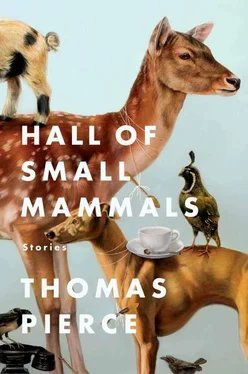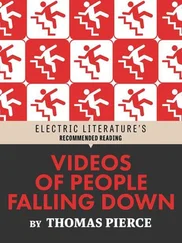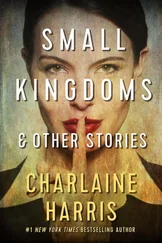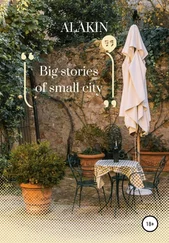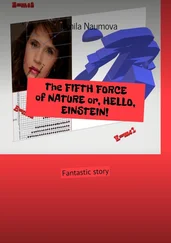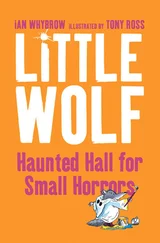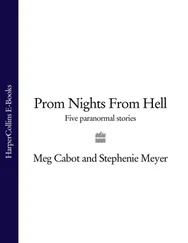• • •
She’s shopping for Christmas gifts at the mall when she sees Harry for the first time since moving back to town. He’s in the parking lot, loading giant boxes into the back of his car. He can’t believe it’s really her. Yes, she changed her hair. It’s shorter. He looks different too. He has a patchy beard and tired eyes.
“My oh my,” he says.
“Let’s get coffee,” she says.
They leave in his car. It’s snowing.
At a café, they order holiday coffee drinks and waters and a figure-eight pastry with some kind of cream filling in the holes like little yellow swimming pools.
Harry runs a food bank now. His jeans are too big for him. They sag low on his hips.
Ellie tells him she’s sorry, about everything, and he nods.
“So, you changed much?” he asks.
Yes, maybe, she says. But then again, probably not. She’s back home, after all.
Harry has big news to share. He’s engaged.
“Who’s the lucky lady?” she asks.
He whips out his cell phone and shows her a photo. The woman in it has brown hair, and she is very aware of the camera. That is, she’s smiling broadly, her teeth twinkling, brilliantly white and possibly a little sharp.
“Her name’s Caroline,” he says. “We met at the church.”
“As in, your mother’s church?” she asks.
“Technically it’s my church now too,” he says. “Caroline’s a teacher. We live on the other side of town.”
Ellie considers asking Harry if his fiancée waves her arms during the songs at church. But she decides that she shouldn’t. That would not be kind. Then she asks it anyway.
Harry smiles and blows a dent into the foam of his pumpkin spice latte.
They haven’t touched the pastry. Harry insists she take it with her, but the look of it makes her feel sick. She isn’t ready to go home yet, and so he drives them to the park, which is empty and a little cold. She wraps her jacket tight and leans into Harry. Through the metal bars of the jungle gym, she watches two gray squirrels chase each other around a tree. Around and around and around. So gratuitous. Harry puts his hand on her knee, and she doesn’t object. It’s like old times. She asks him if he thinks they are alone in the universe, and he smiles and says he reckons not. They climb onto the jungle gym and hang upside down. His hair touches the ground. Her face turns pink. She hopes they’ll make biscuits later.
Our house was more than a hundred and fifty years old and full of mysteries and we loved it. We’d bought it for the original hardwood floors and the ornate plasterwork and the stone fireplace. Soon after we arrived, the man across the street, the unofficial neighborhood historian, dropped off his self-published pamphlet. It included a lengthy essay that said our place had been, at various points, a boardinghouse (1840s/50s), a convalescent home (1890s), the boyhood home of a famous neuroscientist (1920s/30s), a lawyer’s suite (1960s), and a drug house (1990s). Now it was ours: its history, its shoddy plumbing, lead paint, crumbling foundation, all of it.
Reorganizing our boxes in the attic one afternoon, my wife discovered a silvered daguerreotype hidden in the eaves. The woman in the photograph had a pinched, severe-looking face, and she was dressed in some sort of black frock. On the back, the script slanted and faded, was a single word: Lang. This made sense. According to the brochure, the area had been settled mostly by German immigrants.
Not long after that, I was fixing the basement stairs and discovered two red candles and what I guessed was a possum skull concealed beneath the boards. It looked like it had been there a long time. The skull was gray and thin, two small pencil-prick nostril holes below the eyes, the front teeth fanglike and awful and covered in dried drips of red wax. My wife, who grew up Catholic and who can be pretty grim, dubbed the relic Saint Possy and stuck it on our dresser, which meant we had to fall asleep looking at it.
The first night it was there, I dreamed I needed surgery and had to watch a doctor pull what looked like dirty linguini from a hole in my side. The second night I dreamed I was pregnant.
“You can’t blame that stupid skull,” my wife said, and patted its crusty crown.
“Don’t even try to tell me that thing isn’t evil,” I said.
“It’s just bone,” she said. “Just carbon atoms, same as you and me.”
Still, I didn’t want it on the dresser. The skull absorbed light, and after dark it was the brightest object in our bedroom. I threw my shirt over it whenever we had sex because surely any child conceived in its sight was going to come out a monster. I tolerated it for as long as I could — a month, maybe — before packaging it in a shoebox and shoving that toward the back of the closet.
We went out for dinner one night, and I ordered mussels and french fries, and we talked about money because we’d spent most of our savings on the house and we still had more repairs to make. We were thinking about taking in a roommate to make ends meet. When we came home, I polished off a bottle of wine and fell asleep fast, but around midnight I woke up with a full bladder. When I got back from the bathroom, the skull was on the dresser again, the sockets empty and dark.
I shook my wife. She didn’t even open her eyes. She patted my arm. A slow smile crept across her face.
“You’re a jerk,” I said. “Don’t you know you married a man with a gentle heart? Can’t you see what you’re doing to me? And you know that may not even be a possum — the truth is, we don’t know what it is. It could be anything. It could be a deformed baby skull. Remember the photograph from the attic? Maybe it was her deformed stillborn baby, and she built a shrine for it under the stairs.”
I thought my wife had already fallen back asleep, that she wasn’t paying me any attention, but two days later, she came home from work with a strange look on her face, a nervous half smile. I asked her what was wrong, and she pulled a mess of paper towels out of her purse. She unraveled the ball, and there was the skull.
She said she’d taken it to her friend Barry, who taught biology at the university in town.
“And?”
“It’s not a possum skull,” she said. “It’s not a baby skull either. But don’t freak out. He doesn’t really know what it is. He’s never seen anything quite like it.”
We were at the kitchen table. I got up to doctor the soup I was making and then sat back down. I asked her if she thought we should just bury it in the backyard instead. To be done with it.
“Maybe we should put it back under the stairs where we found it,” she said. “It was probably there for a reason.”
The skull was on the table between us. It seemed to breathe. I was losing my appetite. She scraped some of the red wax off the bone, studying it. My wife hadn’t been to church since she was a little girl. She was a Buddhist now, and one of the wonderful things about our house was that she had a room entirely for her meditation, which she did every morning.
“You don’t really think it’s evil, do you?” she asked. “Because I don’t believe in evil. I don’t see things black-and-white.”
“It’s at least a very dark gray,” I said. “If what we’re talking about is a spectrum of goodness.”
“Why were there candles?” she asked. “That is eerie, right?”
We didn’t say anything for a while. The skull grinned at us. Maybe we were waiting for it to talk.
“This is silly,” she said. “I mean, really, what are we so afraid of?”
She snatched the skull off the table and threw it at the floor. The skull didn’t break. It ricocheted toward the door and slid to a stop at the doormat.
Читать дальше
